| Auricularia | |
|---|---|

| |
| Auricularia auricula-judae | |
| Scientific classification | |
| Domain: | Eukaryota |
| Kingdom: | Fungi |
| Division: | Basidiomycota |
| Class: | Agaricomycetes |
| Order: | Auriculariales |
| Family: | Auriculariaceae |
| Genus: | Auricularia Bull. (1780) |
| Type species | |
| Auricularia mesenterica | |
| Species | |
|
over 30 | |
| Synonyms[1] | |
Auricularia is a genus of fungi in the family Auriculariaceae. Basidiocarps (fruit bodies) are typically gelatinous and ear-shaped, with a slightly downy to conspicuously hirsute upper surface and an under surface that is smooth, wrinkled or veined. All species grow on wood. Several Auricularia species are edible and commercially cultivated on a large scale in China and East Asia.
Taxonomy[edit]
The genus was first introduced in 1780 by French mycologist Pierre Bulliard for a range of different fungi producing fruit bodies with an ear-like shape. In 1822 Christian Hendrik Persoon restricted the genus to two gelatinous species, Auricularia mesenterica (which became the type species) and A. sambuci (a synonym of Auricularia auricula-judae).[2] In 1848 Swedish mycologist Elias Magnus Fries accepted A. mesenterica within the genus but, on the basis of differences in fruitbody appearance, introduced a new genus, Hirneola, for most other species.[3] This division into two genera was maintained by some authors until at least the 1960s,[4] though American mycologist Bernard Lowy's monograph of the genus had accepted Hirneola as a synonym of Auricularia in 1952 .[5]
Molecular research, based on cladistic analysis of DNA sequences, has shown that Auricularia (including Hirneola) forms a natural, monophyletic grouping. It has also shown that many species are more restricted in distribution than previously thought, resulting in the description of additional new taxa.[6][7][8]
Description[edit]
All species of Auricularia form thin, brownish, rubbery-gelatinous fruit bodies that are shelf-like or ear-shaped and up to 120 mm (4.7 in) across and 5 mm (0.20 in) thick. The fruitbodies occur singly or in clusters. The upper surface is finely pilose to densely hirsute. The spore-bearing underside is smooth, wrinkled, veined, or reticulate (net-like).[8] Unpigmented white forms are occasionally encountered.[9][10]
Microscopic characters[edit]
The spore-producing basidia are tubular, laterally septate, and (in some species) up to 100 μm long. The spores are allantoid (sausage-shaped), and (in some species) up to 22 μm long. Hairs on the upper surface are thick-walled, rounded or acute at the tip, and (in some species) up to 1 cm (0.39 in) long. When sectioned, some species show a central, medulla layer of parallel hyphae, others lack such a layer.[8]
Habitat, ecology and distribution[edit]
All species grow on wood and are saprotrophic wood-rotters, producing a white rot.[11] Most occur on dead wood, but they can also be weakly parasitic on living wood. The majority of species grow on broadleaf trees and shrubs, but a few grow on conifers. Fruit bodies occur singly, in clusters, or in tiers.[5][8]
The genus has a global distribution, with some species confined to the tropics, others to north temperate regions, and others to south temperate regions.[5][8]
Uses[edit]
At least three species are commercially cultivated for food on a large scale in China and East Asia. They include Auricularia heimuer (black wood ear), formerly misdetermined as Auricularia auricula-judae;[12][7] Auricularia cornea (wood ear or cloud ear), also called A. polytricha; and Auricularia villosula.[8]
Other species are eaten locally around the world. A study on the use of fungi by the Bini people of southern Nigeria found that the local inhabitants collected and ate a species similar to A. auricula-judae, but that it was not one of the fungi they used medicinally.[13] Collection of Auricularia species has also been documented in Nepal. However, the Nepalese do not consider them all that good for eating; of the three grades given to edible fungi, they were given the worst.[14] Additional places where Auricularia species have been recorded as locally gathered and consumed include Benin, Chile, Fiji, Ghana, Guatemala, India, Indonesia, Madagascar, Mexico, Mozambique, and Poland.[15]
Several species, including the Asian cultivated species and the European A. auricula-judae (jelly ear or jew's ear), have been used in traditional medicine.[16] They have also been investigated for potential pharmaceutical use.[12]
Species[edit]
| Image | Name | Type Location | Distribution |
|---|---|---|---|
| Auricularia africana Y.C. Dai & F. Wu (2021) | Uganda | East Africa | |
| Auricularia albida (Romell) Rick (1958) | Paraguay | Paraguay | |
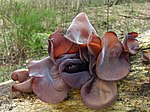 |
Auricularia americana Parmasto & I. Parmasto ex Audet, Boulet & Sirard (2003) | Canada | North America, China, Russian Far East |
 |
Auricularia angiospermarum Y.C. Dai, F. Wu & D.W. Li (2015) | United States | North America |
| Auricularia asiatica Bandara & K.D. Hyde (2016) | Thailand | China, Thailand, Indonesia | |
 |
Auricularia auricula-judae (Bull.) Quél. (1886) | France | Europe |
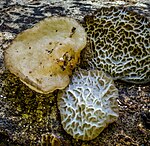 |
Auricularia australiana Y.C. Dai & F. Wu (2021) | Australia | Australia |
| Auricularia brasiliana Y.C. Dai & F. Wu (2015) | Brazil | Brazil | |
| Auricularia camposii Y.C. Dai & F. Wu (2021) | Brazil | Brazil | |
| Auricularia cerrina Kout & Wu 2022[17] | Czech Republic | Czech Republic | |
| Auricularia conferta Y.C. Dai & F. Wu (2021) | Australia | Australia | |
 |
Auricularia cornea Ehrenb. (1820) | Hawaii | Africa, South Asia, North America (Mexico), South America, South Pacific Islands, Australia, New Zealand |
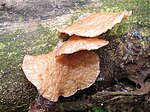 |
Auricularia delicata (Mont. ex Fr.) Henn. (1893) | Guinea | West Africa |
| Auricularia discensa Lloyd (1919) | Brazil | Brazil | |
| Auricularia eburnea L.J. Li & B. Liu (1985) | China | China | |
| Auricularia eminii Henn. (1893) | Congo | Africa | |
| Auricularia eximia (Berk. & Cooke) Kobayasi (1981) | Brazil | Brazil | |
| Auricularia fibrillifera Kobayasi (1973) | Papua New Guinea | New Guinea, China, Africa | |
 |
Auricularia fuscosuccinea (Mont.) Henn. (1893) | Cuba | North America (Mexico, Florida), South America, Caribbean |
| Auricularia goossensiae Beeli (1926) | Congo | Congo | |
| Auricularia hainanensis L.J. Li (1987) | China | China | |
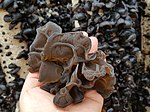 |
Auricularia heimuer F. Wu, B.K. Cui & Y.C. Dai (2014) | China | China, Russian Far East, Japan (Aomori, Iwate, Niigata),[18] Korea |
| Auricularia hispida Iwade (1944) | Japan | Japan | |
| Auricularia incrassata Kobayasi (1973) | Papua New Guinea | Papua New Guinea | |
| Auricularia indica Massee (1914) | Singapore | Singapore | |
| Auricularia lateralis Y.C. Dai & F. Wu (2021) | China | China | |
 |
Auricularia mesenterica (Dicks.) Pers. (1822) | England | Europe, Uzbekistan |
| Auricularia minor Kobayasi (1981) | Taiwan | Taiwan | |
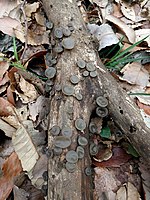 |
Auricularia minutissima Y.C. Dai, F. Wu & Malysheva (2015) | China | China, Russian Far East, Japan (Chiba, Kanagawa, Tokyo, Tottori)[18] |
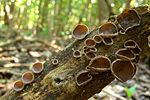 |
Auricularia nigricans (Sw.) Birkebak, Looney & Sánchez-García (2013) | Cuba | North America (Mexico, Florida), Central and South America, Caribbean, southern and eastern Asia |
| Auricularia novozealandica Y.C. Dai & F. Wu (2021) | New Zealand | New Zealand | |
| Auricularia olivaceus B. Kumari, R.C. Upadhyay & Atri (2013) | India | India | |
| Auricularia orientalis Y.C. Dai & F. Wu (2015) | China | China | |
| Auricularia papyracea Yasuda (1918) | Japan | Japan | |
| Auricularia peltata Lloyd (1922) | Philippines | Philippines | |
| Auricularia pilosa Y.C. Dai, L.W. Zhou & F. Wu (2021) | Ethiopia | East Africa | |
| Auricularia rosea Burt (1921) | Costa Rica | Costa Rica | |
| Auricularia scissa Looney, Birkebak & Matheny (2013) | Dominican Republic | North America (Mexico, Florida), Caribbean | |
| Auricularia semipellucida Kobayasi (1942) | Taiwan | Taiwan | |
| Auricularia sinodelicata Y.C. Dai & F. Wu (2021) | China | China | |
| Auricularia sordescens Ces. (1879) | Malaysia | Malaysia | |
| Auricularia srilankensis Y.C. Dai & F. Wu (2021) | Sri Lanka | Sri Lanka | |
| Auricularia stellata Lloyd (1922) | Malaysia | Malaysia | |
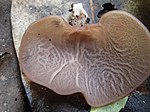 |
Auricularia subglabra Looney, Birkebak & Matheny (2013) | Costa Rica | Central and South America |
| Auricularia submesenterica Y.C. Dai & F. Wu (2021) | China | China | |
| Auricularia tenuis (Lév.) Farl. (1905) | Indonesia | Indonesia | |
| Auricularia thailandica Bandara & K.D. Hyde (2015) | Thailand | China, Thailand, Japan (Okinawa)[18] | |
| Auricularia tibetica Y.C. Dai & F. Wu (2015) | Tibet | China, Tibet | |
| Auricularia villosula Malysheva (2014) | Russian Far East | China, Russian Far East, Japan (Chiba, Kanagawa, Tokyo, Hyogo)[18] | |
| Auricularia wrightii (Berk. & M.A. Curtis) Farl. (1905) | Cuba | Cuba | |
| Auricularia xishaensis L.J. Li 1985 | China | China |
References[edit]
- ^ "Auricularia Bull. ex Juss. 1789". MycoBank. International Mycological Association. Retrieved 2010-07-22.
- ^ Persoon CH (1822). Mycologia europaea 1.
- ^ Fries EM (1848). "Fungi Natalenses". K. Svenska Vetensk-Akad. Handl. Series 3: 144.
- ^ Donk MA (1966). "Check list of European Hymenomycetous Heterobasidiae". Persoonia. 4 (2): 145–244.
- ^ a b c Lowy, Bernard (1952). "The genus Auricularia". Mycologia. 44 (5): 656–92. doi:10.1080/00275514.1952.12024226. ISSN 0027-5514. JSTOR 4547639.
- ^ Looney, B. (2013). "Systematics of the genus Auricularia with an emphasis on species from the southeastern United States". North American Fungi. doi:10.2509/naf2013.008.006. ISSN 1937-786X.
- ^ a b Wu, Fang; Yuan, Yuan; He, Shuang-Hui; Bandara, Asanka R.; Hyde, Kevin D.; Malysheva, Vera F.; Li, De-Wei; Dai, Yu-Cheng (October 2015). "Global diversity and taxonomy of the Auricularia auricula-judae complex (Auriculariales, Basidiomycota)". Mycological Progress. 14 (10): 95. doi:10.1007/s11557-015-1113-4. S2CID 16991202.
- ^ a b c d e f Wu, Fang; Yuan, Yuan; Malysheva, Vera F.; Du, Ping; Dai, Yu Cheng (4 December 2014). "Species clarification of the most important and cultivated Auricularia mushroom "Heimuer": evidence from morphological and molecular data". Phytotaxa. 186 (5): 241. doi:10.11646/phytotaxa.186.5.1.
- ^ Reid DA (1970). "New or interesting records of British hymenomycetes, IV". Transactions of the British Mycological Society. 55 (3): 413–441. doi:10.1016/S0007-1536(70)80062-6.
- ^ Bandara AR, Mortimer PE, VadthanaratS, Xingrong P, Karunarathna SC, Hyde KD, Kakumyan P, Xu J (2020). "First successful domestication of a white strain of Auricularia cornea from Thailand". Studies in Fungi. 5 (1): 420–434. doi:10.5943/sif/5/1/23. S2CID 234995383.
- ^ Worrall, James J.; Anagnost, Susan E.; Zabel, Robert A. (1997). "Comparison of wood decay among diverse lignicolous fungi". Mycologia. 89 (2): 199–219. doi:10.2307/3761073. JSTOR 3761073.
- ^ a b Wu F, Yuan Y, Malysheva VF, Du P, Dai Y (2014). "Species clarification of the most important and cultivated Auricularia mushroom "Heimuer": evidence from morphological and molecular data". Phytotaxa. 186 (5): 241–253. doi:10.11646/phytotaxa.186.5.1.
- ^ Akpaja, Emmanuel Oluwadare; Okhuoya, John Aroye; Ehwerheferere, Benedicta Akpos (2003). "Ethnomycology and indigenous uses of mushrooms among the Bini-speaking people of Nigeria: A case study of Aihuobabekun community near Benin City, Nigeria". International Journal of Medicinal Mushrooms. 7 (3): 373–4. doi:10.1615/intjmedmushr.v7.i3.270.
- ^ Adhikari, M. K.; Devkota, S.; Tiwari, R. D. (2005). "Ethnomycological knowledge on uses of wild mushrooms in western and central Nepal". Our Nature. 3 (1): 13–9. doi:10.3126/on.v3i1.329.
- ^ Boa, Eric (2004). Wild Edible Fungi: A Global Overview of their Use and Importance to People. Food and Agriculture Organisation. ISBN 978-92-5-105157-3.
- ^ Allen, David E.; Hatfield, Gabrielle (2004). Medicinal Plants in Folk Tradition: An Ethnobotany of Britain & Ireland. Timber Press. p. 50. ISBN 978-0-88192-638-5.
- ^ Kout, Jiří; Wu, Fang (March 2022). "Revealing the Cryptic Diversity of Wood-Inhabiting Auricularia (Auriculariales, Basidiomycota) in Europe". Forests. 13 (4): 532. doi:10.3390/f13040532. ISSN 1999-4907.
- ^ a b c d 貴, 白水; 重樹, 稲葉; 秀爾, 牛島; 康仁, 奥田; 栄史, 長澤 (2018). "日本産 "Auricularia auricula-judae " および" A. polytricha " の分子系統解析と形態比較に基づく分類学的検討". 日本菌学会会報. 59 (1): jjom.H30–02. doi:10.18962/jjom.jjom.H30-02.